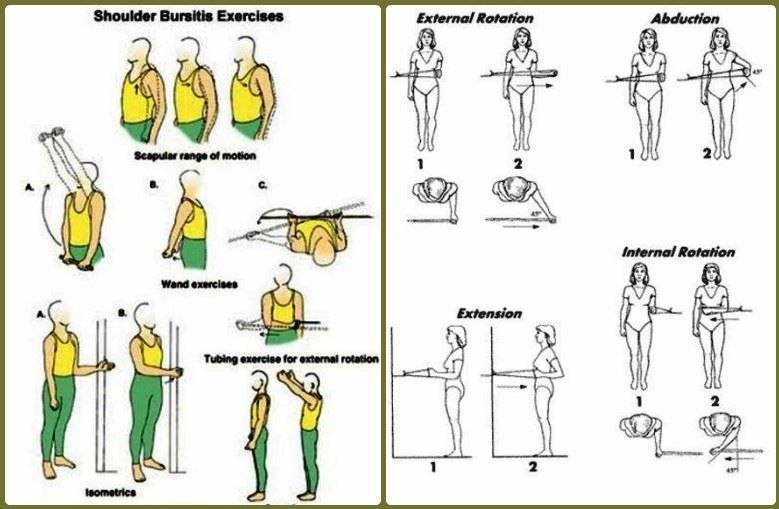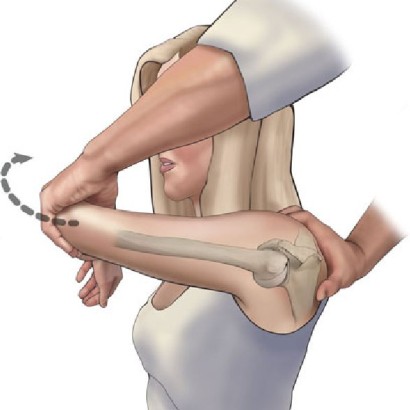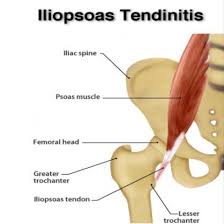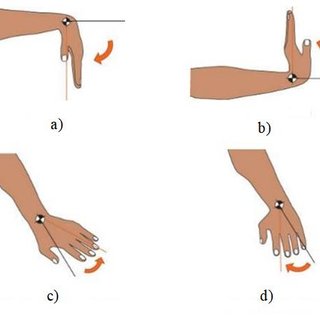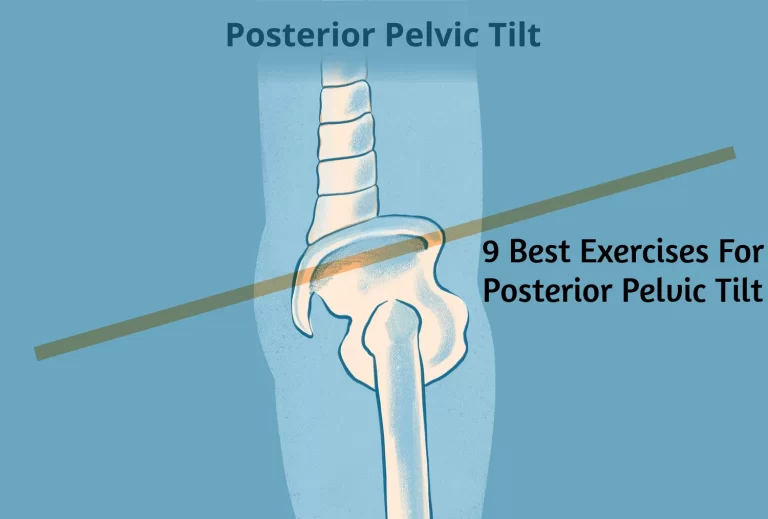Shoulder Exercises for Bursitis
Shoulder exercises is the great way to recover naturally for Shoulder Bursitis, Exercise helps to maintain range of motion and function of Shoulder joint and also improve strength and stability.
What is Shoulder Bursitis?
Bursitis of the shoulder (impingement syndrome) happens when there is swelling and redness between the top of the arm bone and the tip of the shoulder. Between these bones locate the tendons of the rotator cuff and a fluid-filled sac called the bursa, which protects the tendons.
Normally, the tendons glide effortlessly within this space. In some people, this space becomes too narrow for normal movement. This irritates the bursa and tendons, which become inflamed. Inflammation causes the bursa and tendons to swell, making the space for motion still smaller. Eventually, this space becomes too narrow for the bursa and the tendons. Every time they move, they are strained between the bones. This is impingement.
Performing shoulder exercises for bursitis pain will give you benefits. It relieves aches and improves your overhead day-to-day activities. You can do all your gym and other strengthening activities. Doing exercises always gives you lots of advantages. Your daily life will improve by practicing these exercises.
What are the Health Benefits of Shoulder exercises for bursitis?
There are certain health benefits you can gain from exercise:
- Decrease Pain and Swelling around the shoulder joint.
- Improve Movement of the shoulder joint.
- Increase Flexibility and mobility of shoulder muscles.
- Improve posture.
- Increase Strength of shoulder joint.
- Boost Endurance.
What are the exercises for Bursitis of the shoulder joint?
Below are some list of exercises for bursitis:
- Shoulder rotation
- Door presses
- Stick lifts
- Shoulder blade squeeze
- Cross arm stretch
- Table Slides (Flexion)
- Scapular wall slides
- Upper Trap (UT) Stretch
- Open Book Stretch
- Rowing (using a theraband)
- Shoulder blade range of motion
- Shoulder Lift
- Shoulder Rotation Stretch
- Shoulder Flexion Stretch
- Shoulder Blade Compress
- Behind the Back Stretch
- Child’s Pose Bilateral Shoulder Stretch
- Bilateral Shoulder External Rotation with Scap Retraction
- Standing Active Assisted Shoulder Flexion with a Cane
- Wall Angels
- Shoulder Pulley
- Pedal Exerciser
- Rotator cuff external rotations
- The Arnie press
- One arm wall push-ups
Shoulder rotation
Stand upright and lift the shoulders toward the ears. Pause for 5 seconds.
Squeeze the scapulae together behind the back. Pause for 5 seconds.
Pull the scapulae downward toward the heels. Pause for 5 seconds.
Perform 10 times.
Door presses

Stand tall in an open doorway.
Take the injured arm and flex the elbow 90 degrees with your hand in front of you, as if to shake someone’s hand.
Compress the back of the hand into the door-frame.
Pause for 5 seconds.
Perform 15 times.
Stick lifts
Select a stick. A broom handle is better for this exercise.
Stand upright and grasp the stick in both hands with palms facing down.
Slowly lift the stick overhead while keeping the arms straight.
Pause for 5 seconds and slowly lower the arms.
Perform 10 times.
Shoulder blade squeeze
Stand or sit with the arms at your side.
Relax the shoulders so they’re in a normal, resting position.
Move your arms back, squeezing your scapulae together. Hold for a second and then back to your starting position.
Perform two sets of 10 squeezes.
Cross arm stretch

Bring the right arm across the front of the body at chest height.
Flex your left arm at the elbow and press your left forearm against the right arm, pressing the right arm closer to your chest.
Pause for 20 seconds, then switch arms and repeat. Perform three sets.
Table Slides (Flexion)
Begin with your hand on a table (facing the table) on a towel, Stretch the arm forward on the table by sliding the towel.
Feel a stretch under the arm.
Perform 20-30 repetitions.
This exercise is altered for abduction as well.
Scapular wall slides
Stand in a straight position with your back against the wall.
Lift your arms in 90 degrees abduction and flex your elbows to the 90-degree position as well.
The arms have to be pressed against the wall at all times.
Ensure your hand palms are facing forward.
Now you will abduct the arms as high as you can while extending the elbows at the same time.
Perform this slowly and go back to the starting position.
Perform 10 – 12 repetitions.
Upper Trap (UT) Stretch
Sit on a table or chair and utilize the hand of the affected side to grip under the table, stabilizing the shoulder downward.
With the other hand, pull the head to the other shoulder, maintaining your gaze forward and experiencing a stretch in the upper trap muscle.
Pause for 30 seconds and do 1-3 repetitions two times a day.
Open Book Stretch
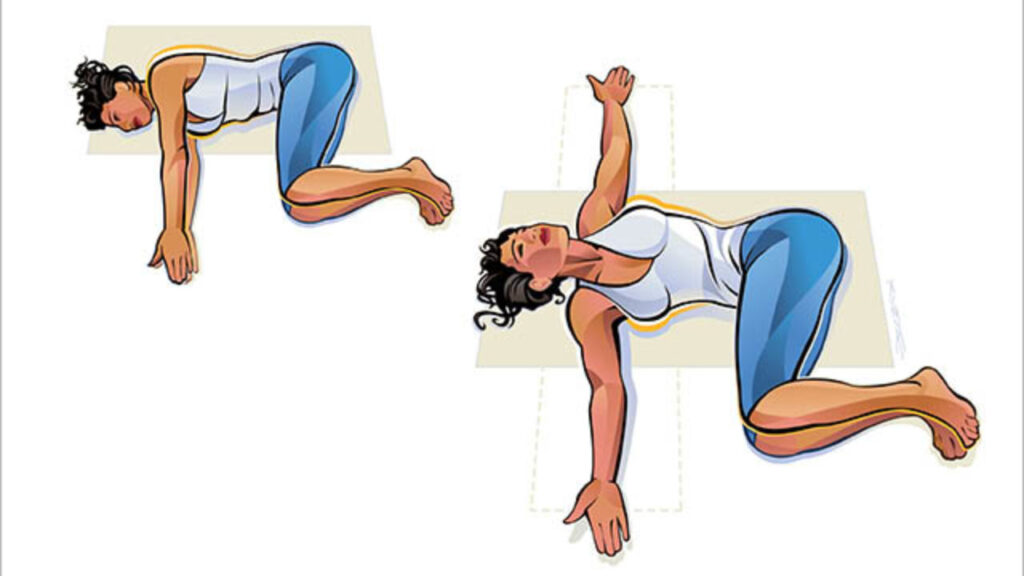
Put a rolled-up towel on a mat table between the scapulae and lie flat on your back.
Keep your arms folded together over the top of the body, with your hands together.
Open your arms up, like you are mimicking the opening of a book, feeling a stretch in the front of your shoulder.
Pause for 30-60 seconds and do 1-3 repetitions two times a day.
Rowing (using a theraband)
This is the best exercise to train the scapular stabilizing muscles.
Sit in a chair or stand. Anchor a theraband to a door or pole, ensuring that the anchor point is around chest level.
Pull the theraband backward most importantly pulling the scapulae together.
Perform two sets of 10-20 repetitions three times a week.
Shoulder blade range of motion
Raise your shoulders as if you are shrugging them, holding the pose for 5 seconds. Lower the shoulders.
Move the shoulders down to feel a stretch across the upper part of the shoulders. Pause this position for 5 seconds.
Roll the shoulders in a circular motion backward for 5 circles. Stop and do it again by rotating the shoulders forward.
Shoulder Lift
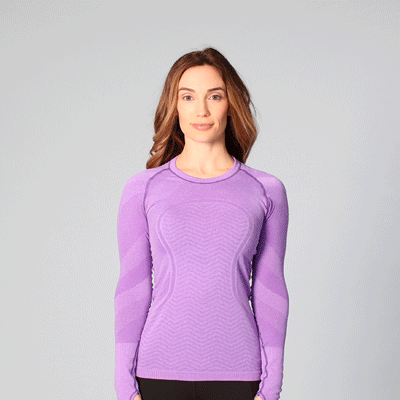
Stand tall and breathe in, raising both shoulders as if you were shrugging.
Pause and release back down with the out-breath.
Repeat 5 times.
Shoulder Rotation Stretch
With your affected arm at the bottom, grab the other end of the towel near your head.
Slowly lift your upper arm as high as it can go and hold for 6 seconds.
Pull down with the lower arm to the start position.
Repeat 5 times.
Shoulder Flexion Stretch
Grab the broomstick or bar with both hands, equidistant apart.
Keeping straight posture and both legs firmly on the floor, slowly lift your hands at the same time.
Once the bar is directly over your head pause for 3 seconds and then slowly lower it back down.
Do it 10-20 times.
Shoulder Blade Compress
This exercise can be performed anytime, anywhere, and helps a lot with realigning your back and relaxing the shoulder muscles.
Standing or sitting, ensure your arms are relaxed and to your side.
Gently pull your scapulae together at the back and push out your chest at the same time.
Pause for 5 seconds, releasing your breath as you let the shoulders fall back into their initial position.
Do it 5-7 times.
Behind the Back Stretch

Bring your injured arm behind the back so that the back of your hand is resting on the upper part of your glutes.
This may already be enough of a stretch, if so just simply pause, otherwise continue with the following steps.
Bring your opposite hand behind the back as well and grasp your hand that’s already resting there, the opposite hand should be now closest to your back.
Now, utilize your opposite hand to gently pull your arms across your back.
Continue moving until you experience a comfortable stretch in the front of the shoulder and hold.
Pause for 30+ seconds for 2-3 sets.
For a stronger stretch, you can attach a stretch strap and pull your hand up toward the scapulae (your opposite hand will be guiding from above this time). This will stretch a different part of your shoulder capsule and assist to increase your internal shoulder range of motion further.
Child’s Pose Bilateral Shoulder Stretch
Getting on your hands and knees is a great way to utilize your body weight to get a deep overhead shoulder stretch. If this stretch doesn’t feel comfortable, you can always utilize a pulley or lie on your back with a cane to stretch as well.
Begin by getting in a quadruped position on your hands and knees.
Make sure the knees are directly below the hips.
Start to transfer your butt toward your heels as you reach your hands out further on the ground.
Continue transferring until you have you feel a strong stretch, or your upper arms are in line with the ears (whichever comes first)
Pause the stretch for 30+ seconds for 2-3 sets total.
Bilateral Shoulder External Rotation with Scapular Retraction
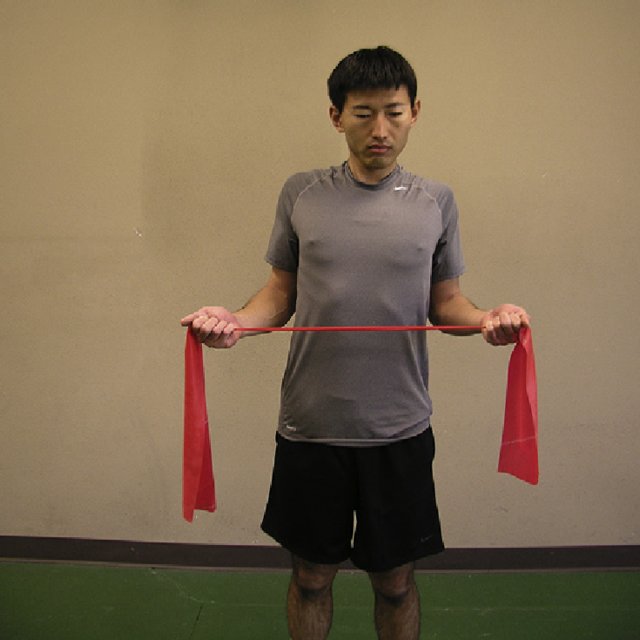
Grasp a resistance band for this one.
Stand in good posture with the arms at your side, elbows flex to 90 degrees, and palms facing up toward the roof.
Grab the band in both hands at a resistance level that is manageable yet challenging.
Tighten and squeeze the scapulae together as you pull your hands further apart.
Keep the elbows tightly tucked into the side and neck relaxed throughout.
Pull the arms apart as far as is comfortable before slowly reversing to the starting position.
Do it 10-15 times for 2-3 sets.
If this is too hard or painful for your shoulder, you can downgrade to isometrics “pushing” exercises. This means you keep the arm still as you give resistance with your opposite hand in various directions. When you’re ready to progress to other shoulder exercises with a resistance band, you can also practice internal rotation, shoulder flexion, shoulder abduction, rows, and more.
Standing Active Assisted Shoulder Flexion with a Cane
Stand comfortably and grasp a walking cane, dowel, or broomstick.
Grab the cane in your hands at shoulder width down at your thighs.
Keep a good upright posture and the neck relaxed as you raise both hands toward the ceiling.
Raise as high as possible, slowly and with control.
Then, return gently to the starting position.
Do 10-15 times for 2-3 sets total.
With time, you can add weights or a resistance band and concentrate on one arm at a time. Other arm motions to try are shoulder abduction (out to the side) and shoulder scaption (at a diagonal).
Wall Angels
Stand against a wall with feet 6-12 inches from the wall.
Position yourself so that your whole spine is aligned with the wall and the back of your head is touching the wall (with your line of vision parallel to the ground), it’s okay if there is a small gap at your low back.
Bring the arms up on the wall into a “touchdown” position while maintaining them flat against the wall, the shoulders should be abducted and elbows flexed to around 90 degrees each.
For some, this may be an adequate challenge to hold, otherwise, continue with the next move.
Keep the forearms parallel with each other as you slide your arms up the wall as high as you can while keeping good form.
Slide up and down the wall while maintaining the neck relaxed.
Do it 10-15 times for 2-3 sets total.
Shoulder Pulley
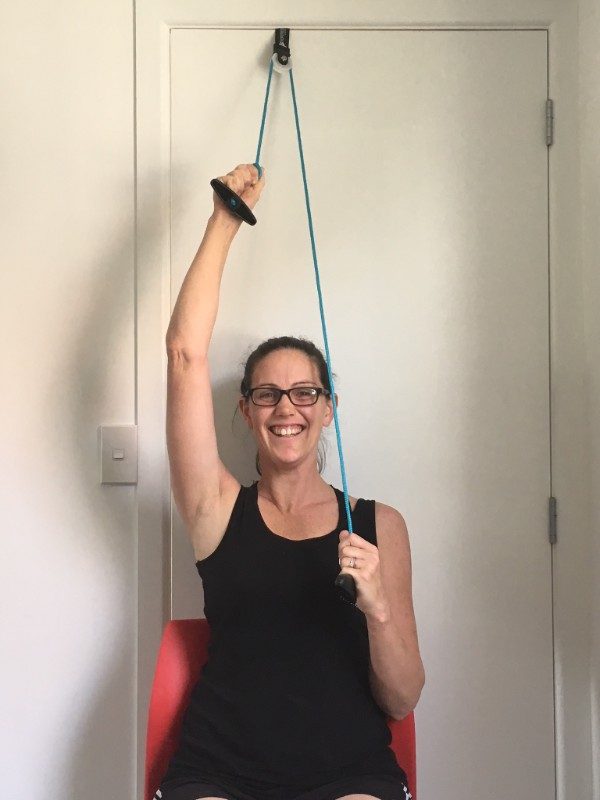
This basic rehab equipment can be found in every physical therapy clinic.
The shoulder pulley is great versatile equipment for comfortably boosting your shoulder’s flexibility.
It is important if you are recovering from shoulder surgery or severe pain that limits the ability to actively move your shoulder.
It can also aid prevent or treating a frozen shoulder.
Simply close it in a door and place yourself up in a chair underneath it.
Utilize your uninjured arm to guide the injured arm passively into limited ranges.
With time, you will observe a big difference and you can decrease the amount of assistance you require from the opposite arm.
Pedal Exerciser
While a pedal exerciser may be traditionally used for leg motion and strength, it can easily be used for the arms too.
Simply place it on a surface that is between hip and chest height and put your hands on the pedals.
Turn the pedals backward or forwards while maintaining good posture.
This motion helps warm up and loosen the shoulders by improving circulation and tissue extensibility.
Rotator cuff external rotations
Lie on your side with the elbow touching your side and at a right angle.
Rotate your fist up, keeping the elbow at 90 degrees and on your side, and then lower down again.
Select the weight where your tire is out at about 10 reps (often 1/2 or 1 kg is enough, to begin with) and perform 3 sets to fatigue (10-15).
The Arnie press
Begin with a weight that makes the muscles tire at about 10 reps (this could be 1kg, a drink bottle, or even 5kg).
Your hand should be in front of the shoulder and knuckles forward.
Press upwards, while rotating through the range so that the knuckles are backward, and then go back down to the beginning position, rotating through the range again.
3 sets of 12-15 reps usually, otherwise adjust the weight.
One arm wall push-ups

This is a great one for getting overall strength and control of the shoulder girdle and for a lot of people with shoulder bursitis, is pain-free to do.
Place your hand in front of the shoulder (you don’t want it too high) and perform a push-up, looking to keep the shoulders level and not tilting into the wall with the opposite side.
Adjust the distance the feet are out from the wall to make it challenging but doable.
Perform 3 sets of 10.

